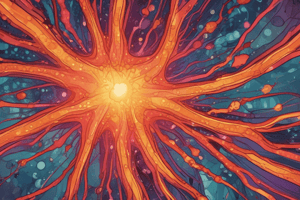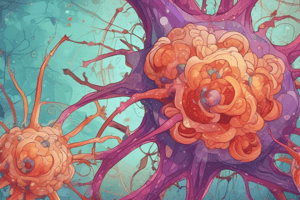Podcast
Questions and Answers
What is the primary purpose of inflammation?
What is the primary purpose of inflammation?
- To initiate apoptosis in damaged cells
- To decrease blood flow to affected areas
- To eliminate the cause of cell injury (correct)
- To promote cell division in healthy tissues
Which of the following is NOT considered a trigger for acute inflammation?
Which of the following is NOT considered a trigger for acute inflammation?
- Enhanced cell proliferation (correct)
- Viral infections
- Infection
- Autoimmune conditions
What role do mast cells play in the acute inflammatory response?
What role do mast cells play in the acute inflammatory response?
- They directly kill pathogens
- They transport nutrients to injured tissues
- They strengthen blood vessel walls
- They detect injury signals and release histamine (correct)
What is one of the clinical signs of acute inflammation?
What is one of the clinical signs of acute inflammation?
During which stage of acute inflammation do phagocytes and other immune cells arrive at the injury site?
During which stage of acute inflammation do phagocytes and other immune cells arrive at the injury site?
Which mediators are primarily released by mast cells as part of the acute inflammatory response?
Which mediators are primarily released by mast cells as part of the acute inflammatory response?
What characterizes the systemic response during acute inflammation?
What characterizes the systemic response during acute inflammation?
Which of the following outcomes is possible after an episode of acute inflammation?
Which of the following outcomes is possible after an episode of acute inflammation?
What is the primary mechanism that causes vasodilation in acute inflammation?
What is the primary mechanism that causes vasodilation in acute inflammation?
How does increased vascular permeability affect the surrounding tissue?
How does increased vascular permeability affect the surrounding tissue?
What sequence describes the steps in white blood cell migration?
What sequence describes the steps in white blood cell migration?
Which mediator is primarily responsible for the constriction of smooth muscles in the intestine during acute inflammation?
Which mediator is primarily responsible for the constriction of smooth muscles in the intestine during acute inflammation?
Which outcome of acute inflammation involves the formation of non-functional tissue?
Which outcome of acute inflammation involves the formation of non-functional tissue?
What are common clinical signs of systemic inflammation?
What are common clinical signs of systemic inflammation?
Which type of exudate is characterized by thick, colored pus containing white blood cells?
Which type of exudate is characterized by thick, colored pus containing white blood cells?
What distinguishes chronic inflammation from acute inflammation?
What distinguishes chronic inflammation from acute inflammation?
Which mediator is NOT released from mast cells during acute inflammation?
Which mediator is NOT released from mast cells during acute inflammation?
During which phase of acute inflammation are neutrophils predominant?
During which phase of acute inflammation are neutrophils predominant?
What is the normal physiological response associated with pain during inflammation?
What is the normal physiological response associated with pain during inflammation?
Which characteristic is associated with systemic inflammatory response syndrome (SIRS)?
Which characteristic is associated with systemic inflammatory response syndrome (SIRS)?
What is the primary cause of sepsis?
What is the primary cause of sepsis?
Which effector function is NOT performed by immune cells during acute inflammation?
Which effector function is NOT performed by immune cells during acute inflammation?
Flashcards are hidden until you start studying
Study Notes
Acute Inflammation
- Definition: A protective response eliminating cell injury causes and removing damaged products/cells. Two main functions: stopping the attack and repairing the damage.
- Triggers: Infection (bacterial, fungal, toxin), injury/foreign bodies/trauma, immunological reactions (autoimmune conditions), chemical agents, and radiation.
- Stages:
- Recognition of danger: Tissue-resident immune cells (mast cells, macrophages) detect injury via PRRs (like Toll-like receptors), recognizing pathogen factors (PAMPs) and stressed cells (DNA, heat shock proteins). They release histamine, nitric oxide (NO), and other chemicals.
- Vasodilation and increased vascular permeability: Histamine and NO mediate vasodilation (increased blood vessel diameter), leading to stasis (slow blood flow aiding leukocyte movement), erythema (redness), and warmth. Increased permeability allows protein-rich exudate into tissues, causing edema (swelling). This delivers immune cells and mediators and clotting factors.
- Chemotaxis: Recruitment of immune cells. WBC migration involves rolling, adhesion, and transmigration across the endothelium. Neutrophils arrive first (6-24 hours post-injury), followed by monocytes (macrophages), lymphocytes, and sometimes eosinophils (24-48 hours).
- Systemic Response: Pyrexia (fever) and pain.
Acute Inflammation Mediators
- Preformed mediators (Mast cell degranulation): Histamine (vasodilation, bronchoconstriction, intestinal cramps/diarrhea), cytokines (TNF-α, IL-1, IL-6), chemokines (for neutrophils and eosinophils), and enzymes (tryptase, chymase, cathepsin – connective tissue changes, tissue breakdown).
- Secondary mediators (synthesized upon Mast cell activation): Eicosanoids (leukotrienes, prostaglandins, thromboxanes – increased permeability, platelet aggregation, bronchoconstriction) and Th2 cytokines (IL-4, IL-5, IL-13, GM-CSF).
Cardinal Signs of Inflammation
- Redness (Rubor): Increased blood flow.
- Heat (Calor): Increased blood flow.
- Swelling (Tumor): Exudation of fluid.
- Pain (Dolor): Release of chemical mediators, stretching of nerves by exudates.
- Loss of Function (Functio Laesa): Pain and tissue disruption.
Types of Exudates
- Serous: Cell-free plasma.
- Fibrinous: Increased fibrinogen for wound repair.
- Mucinous: Thick, clear gel-like mucous.
- Purulent: Thick, colored pus (WBCs).
- Sanguineous: Fresh bleeding.
- Mixed: Combinations (e.g., serosanguineous, mucopurulent).
Outcomes of Acute Inflammation
- Resolution: Damaging agent removed, damage repaired, full function restored.
- Abscess Formation: Walled-off pus collection (neutrophils, necrotic tissue).
- Fibrosis (Scar) Formation: Excessive connective tissue, hard, non-functional tissue.
- Chronic Inflammation: May follow acute inflammation or be a separate process.
Systemic Inflammation
- Signs: Pyrexia (fever), tachycardia (increased heart rate), rigors (chills), diaphoresis (sweating), leukocytosis (increased WBC count), lethargy, confusion, hypoxia. Caused by local inflammation mediators/toxins entering systemic circulation.
- Spectrum:
- Systemic Inflammatory Response Syndrome (SIRS): Caused by infection or trauma, includes all signs of systemic inflammation.
- Sepsis: Body's response to severe infection.
- Septic Shock: Most severe sepsis; bacteria/infectious agents in blood, end-organ damage, hypotension, often fatal.
Chronic Inflammation
- Characteristics: Sustained response to injurious stimuli, long duration (days to years), involves lymphocytes (B and T cells) and macrophages.
- Causes: Persistent infection (viral or bacterial), autoimmune dysfunction, chronic diseases.
- Mediators: Proteases, cytokines (TNF, IL-1, interferon-γ), NO, eicosanoids, angiogenesis factors (PDGF, FGF, TGF-β).
- Granuloma Formation: Accumulation of mononuclear WBCs (macrophages, lymphocytes), epithelioid cells, and multinucleated giant cells in damaged tissue, associated with mycobacterial or fungal infections and chronic injury from foreign agents (e.g., silica).
Acute vs. Chronic Inflammation
- Acute: Immediate protection, rapid onset (minutes), exudates and neutrophil migration, triggered by infection, immunological responses, trauma, or foreign bodies.
- Chronic: Sustained response, long duration (days to years), involves lymphocytes and macrophages, caused by persistent infection, autoimmune dysfunction, or chronic diseases.
Studying That Suits You
Use AI to generate personalized quizzes and flashcards to suit your learning preferences.




